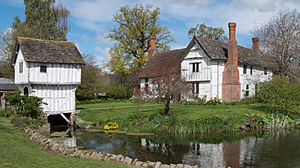Meriel Lyttelton facts for kids
Meriel Lyttelton (died 1630) was an English noblewoman with many connections to important families and the royal court. She was the daughter of Sir Thomas Bromley and Elizabeth Fortescue. Her nephew, Thomas Bromley, was a Member of Parliament (MP) for Worcestershire.
Contents
Trouble with the Earl of Essex
Meriel married John Lyttelton of Hagley and Frankley. John Lyttelton was put in prison after a rebellion led by the Earl of Essex. While in prison, he wrote to Meriel asking her to organize his affairs and keep his important legal papers safe. In another letter, he asked her to burn some letters that were in a special box.
In February 1601, Meriel went to Frankley House to get some letters. However, the Sheriff of Worcestershire, John Washburn, stopped her. He found letters for Charles Danvers, who was involved in the Essex rebellion, in a desk in her room. John Lyttelton later died in prison.
Meeting the New King
In 1603, when King James VI of Scotland became King James I of England (this was called the Union of the Crowns), Meriel Lyttelton traveled north to Doncaster to meet him. She had asked for her family's lands to be given back to them. The new king agreed, and her family got their estates back on June 17, 1603. This was called a "reversal of attainder," which meant the legal punishment against her family was lifted.
Life at Court and Family Letters
Amphylis Barneby, a friend and relative, wanted to find a job for her cousin in the household of Prince Henry, the king's son. She wrote to Meriel Lyttelton for help. Meriel explained that it was very hard to get these court jobs because many people wanted them for the social benefits they could bring. She told Mrs. Barneby that her young cousin probably wouldn't get a place.
Meriel Lyttelton's own brother, Henry Bromley, was in a better position to help his son get a job with the Prince, but he decided to wait for a better time. Meriel's letter was likely written around 1604.
The Gunpowder Plot Connection
In January 1606, two people involved in the Gunpowder Plot, Robert Wintour and Stephen Lyttelton, were found at Hagley. Their weapons exploded after a cook told the authorities where they were. Meriel Lyttelton was not there at the time. Her brother-in-law, Humphrey Littleton, was executed by hanging on April 7, 1606, along with others involved in the plot.
Meriel's Letters
Meriel Lyttelton kept a book of her letters. She wrote to Lady Elizabeth Fenton, the wife of a Scottish nobleman, turning down an invitation to spend the summer with her. In a letter from 1606, she promised to visit her in London.
She also wrote to a friend about her problems with Thomas Coningsby, a relative who was trying to take some woodland that belonged to her. Meriel also wrote to her aunt, Muriel Knyvett, about legal matters, religion, and family events. She discussed how much it cost to send her sons to school and to Oxford University. After her husband died, she shared her difficulties with her aunt.
Meriel Lyttelton had rights in the town of Halesowen. In June 1608, she made a public announcement against a Sunday market that sold dairy products, because it was breaking the rules about not working on the Sabbath (Sunday).
A painting of Meriel Lyttelton was at Hagley Hall in 1775. She passed away on April 30, 1630, and was buried at St John the Baptist Church in Hagley. A later inscription there remembers her.
Meriel's Family
Meriel Lyttelton had several children, including:
- Sir Thomas Lyttelton, who became the 1st Baronet.
- Humphrey Littleton, who was executed for his part in the Gunpowder Plot.
- Bridget Lyttelton, who married Robert Tracy, the 2nd Viscount Tracy.



